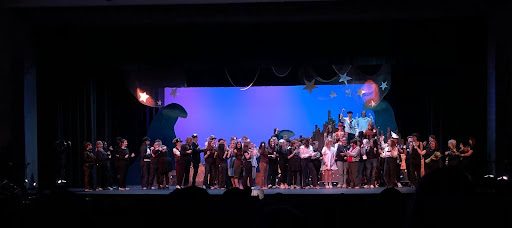Funny and French: ‘The Lady from Maxim’s’
For three days in late November, WS’ theatre department transformed the auditorium into an elegant Parisian home and a countryside chateau.
The Lady from Maxim’s, WS’ fall play, is a three-act French farce set in 1899. It starred junior Catherine Ariale as The Shrimp, sophomore Forrest Browne as Dr. Petypon, senior Joshua Elliott as General Petypon du Grele, senior Ellen Abood as Madame Petypon and senior Shane Chase as Mongicourt.
The caveat at the bottom of all advertisements cautioned that Maxim’s “may contain humor, language and situations not appropriate for younger audiences.” Never has this kind of warning held so true—from beginning to end, Maxim’s was full of not-so-subtle innuendo. Though it was undoubtedly funny, it became slightly tiring when occasionally presented in constant volleys. Spread out, however, it was brilliant and became a centerpiece of the play. Most of the credit for the hilarious delivery of innuendo goes to Chase’s Mongicourt, Dr. Petypon’s friend and fellow doctor. Ariale’s teasing Shrimp, Browne’s stressed Petypon and Abood’s ‘haunted’ Madame Petypon were also laughter inducing.
As funny as it was, it was not appropriate for younger audiences, surely making some parents of elementary and middle school students uncomfortable. Though the play was performed by high school students and directed toward older audiences, it would have been nice if it were family-friendly. Nevertheless, Maxim’s made its mature audience members laugh so hard they doubled over and almost cried.
For their part, the actors and actresses did a marvelous job. Their delivery and movements were spot-on, and they seemed to embody their characters; the audience felt as if it was looking in on the characters’ lives, not watching a high school play. They never broke character, not even when the audience was roaring with laughter. Though Maxim’s was certainly rehearsed many times, the actors did not give off the been there, done that, robot delivery that sometimes comes with over-rehearsing.
The costumes were true to turn-of-the-century fashion. Madame Petypon’s giant bustle perfectly complemented her character—her white blouse and black skirt evidenced her piousness and simplicity, but the bustle hinted at a flair for the dramatic. It was also just the style of the day. The frilly, lacey dresses worn by the other actresses were also historically accurate.
The sets, designed by Theater Tech students, were one of my favorite parts. The walls looked real and the doors seemed like they opened to hallways. It lent a lot of authenticity to the play as a whole. I really have no idea what Parisian homes and countryside chateaus looked like at the end of the nineteenth century, but Maxim’s sets felt perfectly accurate.
Though WS has closed the curtains on The Lady from Maxim’s, the production proved that our theatre department is carrying on its award-winning tradition.





